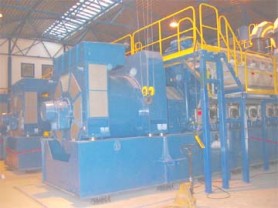-but rates unlikely to drop
The Guyana Power and Light Company’s (GPL) new Kingston plant is expected to boost power production by 20 megawatts, but it is not likely to result in any reduction in rates given current losses from electricity theft, Chief Executive Officer Bharrat Dindyal said yesterday.
He was at the time speaking with reporters during a tour of the plant, which consists of generation equipment as well as supportive apparatus and the Finnish made equipment has cost the company some US$30 million. The equipment will result in some reduction in fuel consumption since it will burn some 55 imperial gallons for 100 units of electricity, while the old units used up more that 58 imperial gallons, Dindyal explained. It would also allow the power company to reduce its dependence on diesel from 28% to 5% overall. However, when asked about the trickle-down effect and whether the additional generation would result in an ultimate reduction of rates, Dindyal emphasized that it may reduce production costs. “We will see what we will do ’cause it may help a reduction in production cost. This in itself will help us only so much because we really need to roll back losses,” he said. On the reduced dependence on diesel, he pointed out that the diesel is expensive. He explained too that heavy fuel is now more expensive than crude oil.

Moreover, load shedding as a result of generation shortfall will be reduced, resulting in less frequent power outages.
Currently, with the excessively hot weather, GPL’s demand for power has peaked at 69 megawatts during the day and over 70 at nights. As a result, the new facility, which will be hooked up to the current generation system late next month, will add significant value in terms of production costs and the ability to meet demand.
Meanwhile, responding to questions on the pre-paid metering system, Dindyal said he felt enough work was done to publicise the technology and its advantages. “So I think it’s time for people to embrace the technology and utilize all its facilities and the advantages it offers,” he said. He revealed too that he was currently using one of the meters at his home and with his first purchase of power he has been able to reduce consumption by 7%.
The installation of the new metering system in Festival City as part of the pilot project had reaped negative reactions but Dindyal said this did not mean that the company had backed off. However, he conceded that there was need for the company to have persons reflect on what was being done. He added that GPL was continuing to work with those who have meters and the others to let them realize that it is something for their good and a powerful tool for conservation.
Dindyal made it clear that the meter was not to “press anyone or in any way intended to change their standard of living or profile. It is here for all of us to use. You have to interact with the technology to understand what it could do for you,” he implored.
GPL currently has 2,300 pre-paid meters in stock and is hoping to buy 300 more by year-end. Only 14 have been installed and the company has appealed to its staff to volunteer. Advertisements have also been placed in the media for members of the public to volunteer. Dindyal said consumers in West Ruimveldt have taken it up and it is helping them to manage consumption.
Instead of making the meters mandatory at this point, he said the company prefers to have the technology “rolled out. I think in every village some people want it and we want to give it to them to market it for us.”
Dindyal also revealed that GPL is to start a US$40 million project shortly to deal with the issue of technical losses. This project, he said, will provide links with Berbice. A Chinese team, which will set up the line loss project, is to arrive shortly to sign an agreement and start design works. According to him, the team has submitted a 28-and-a-half month programme with a US$23 million scope of works. Its main areas will be the setting up of new substations throughout Deme-rara, interconnection of the Berbice and Demerara systems, interconnection of East and West Demerara by transmission as well as a state-of-the-art controlled system to manage and dispatch power efficiently. This management system is to be installed at the Sophia power station.





